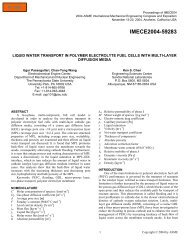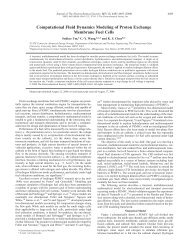DMFC stack.pdf - Electrochemical Engine Center
DMFC stack.pdf - Electrochemical Engine Center
DMFC stack.pdf - Electrochemical Engine Center
Create successful ePaper yourself
Turn your PDF publications into a flip-book with our unique Google optimized e-Paper software.
1046<br />
G. Q. LU ET AL.<br />
0.7<br />
0.6<br />
0.5<br />
Air breathing <strong>DMFC</strong><br />
Anode 4.8 mg/cm 2 Pt/Ru<br />
Cathode 0.9 mg/cm 2 Pt, Nafion ® 112<br />
5cm 2 cell, 2M methanol<br />
ξ a =2@150mA/cm 2<br />
Room temperature<br />
40<br />
30<br />
Voltage (V)<br />
0.4<br />
0.3<br />
20<br />
Power density (mW/cm 2 )<br />
0.2<br />
10<br />
0.1<br />
Voltage<br />
Power<br />
0<br />
0<br />
0 25 50 75 100 125 150 175<br />
Current density (mA/cm 2 )<br />
Figure 6. Polarization and power curves of cell #1 with 2 M methanol feed.<br />
to cathode by electro-osmotic drag through the membrane, which is about 2:5 6 mols per mol<br />
of methanol assuming the electro-osmotic coefficient to be 2.5 per proton for thick membranes,<br />
such as Nafion 117 (Ren and Gottesfeld, 2001). Therefore, a total of 18 mol of water per mol of<br />
reacted methanol accumulates at the cathode if there is no water back diffusion effect. This<br />
excessive amount of water results in severe electrode flooding (Lu and Wang, 2005).<br />
An innovative water management technique was implemented in this <strong>DMFC</strong> <strong>stack</strong> by<br />
applying a highly hydrophobic microporous layer in the cathode to create hydraulic pressure<br />
buildup, and by using a thin membrane (e.g. Nafion 112) to facilitate water backflow via<br />
hydraulic permeation (Lu et al., 2005). By properly tailoring the contact angle and the micro<br />
pore size of the microporous layer, net water crossover through the MEA can be reduced<br />
dramatically. The total rate of water arrived and produced at the cathode can be written as<br />
follows:<br />
<br />
j H2 O ¼ a þ 1 I<br />
ð1Þ<br />
2 F<br />
where I is the total current, F is Faraday’s constant, and a is the net water transport coefficient, a<br />
combined result of electro-osmotic drag, diffusion, and hydraulic permeation through the<br />
membrane. At 308C, the net water transport coefficient, a, for this newly developed MEA is only<br />
0.12 at an air stoichiometry, x c , being 4 at 150 mA cm 2 (Lu et al., 2005), as compared to the<br />
Copyright # 2005 John Wiley & Sons, Ltd. Int. J. Energy Res. 2005; 29:1041–1050




